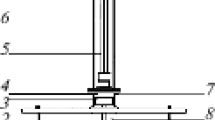Summary
The case treated is that of a straight tube open at both ends and provided with a hot wire gauze composed of a thin spirally wound metallic wire. The general form of the characteristic equation governing the excitation of sound when air is forced to flow through the tube was derived in a previous paper. A discussion now follows of the transfer functions of the hot wire gauze and the dissipation of acoustic energy in the tube; it is shown that a first-order solution of the characteristic equation can be obtained that accounts for the main features of the Rijke-tube phenomenon, viz. that excitation of the fundamental frequency of the tube occurs only when the hot wire gauze is in the entrance half of the tube, and that maximum excitation occurs when it is located at about one fifth of the tube length from the entrance. Neutral curves for the fundamental frequency are calculated which show that for excitation to occur the Strouhal number of the hot wire should have a value within a critical range. This means that to any given dimensions of the tube and the wire gauze there corresponds a critical range of values of the mean velocity of the gas flow outside which there should be no sound generation. Finally neutral curves for the first overtone are presented that show that there are two positions of the wire gauze that give rise to excitation of this harmonic.
Similar content being viewed by others
Abbreviations
- Ad :
-
heat-exchanging area of the wire gauze or an area related to it.
- c:
-
dimensionless number defined by (2,9).
- d:
-
thickness of the wire of the gauze.
- k:
-
wave number (= ω/a).
- ke :
-
effective wave number.
- l:
-
length of the tube.
- le :
-
effective length of the tube (= l+lm).
- lm :
-
mass-end correction of open end.
- n:
-
number (= 0, 1, 2,...).
- N:
-
reflection coefficient of the output impedance of a tube.
- Pe:
-
Péclet number (= Pr Red).
- R:
-
radius of the tube.
- Red :
-
Reynolds number of the wire of the gauze (\( = \bar U_1 d/v_1 \)).
- St:
-
Strouhal number of the wire of the gauze (\( = \bar U_1 /(df)\)).
- Tω:
-
temperature of the surface of the gauze.
- w:
-
wave impedance.
- z:
-
specific acoustic impedance (= AZ).
- α:
-
heat transfer coefficient of the wire gauze.
- β:
-
dimensionless number defined by (2,13).
- θ:
-
normalized radiation resistance of an open end of a tube.
- ϰ:
-
reduced wave number defined by (2,28).
- λ:
-
thermal conductivity of fluid.
- ξ:
-
reduced distance of heater from entrance of the tube.
- \(\bar \rho _e \) :
-
effective mean density.
- Τ:
-
time lag.
- χ e :
-
effective compressibility
- \(\tilde \omega \) :
-
reduced circular frequency (\( = \omega d/\bar U_1 in \S 2\),=ωτ in § 4)
- s:
-
quasi-steady fluctuations.
References
Merk, H. J., Appl. Sci. Res.A6 (1957) 317.
Rijke, P. L., Pogg. Ann.107 (1859) 339 and Phil. Mag.17 (1859) 419.
Neuringer, J. L. and G. E. Hudson, J. Acoust. Soc. Amer.24 (1952) 667.
Putnam, A. A. and W. R. Dennis, J. Acoust. Soc. Amer.26 (1954) 716.
Lord Rayleigh, Theory of Sound, vol. 2, 2nd ed., Dover Publications, New York, 1945.
Carrier, G. F., Quart. Appl. Math.12 (1955) 383.
Lehmann, K. O., Ann. Phys. Lpz.,29 (1937) 527.
Lighthill, M. J., Proc. Roy. Soc. LondonA 224 (1954) 1.
Stuart, J. T., Proc. Roy. Soc. LondonA231 (1955) 116.
Rott, N., Quart. Appl. Math.13 (1956) 444.
Cole, J., and A. Roshko, Heat transfer from wires at Reynolds numbers in the Oseen range, preprint of papers of the Heat Transfer and Fluid Mechanics Institute, June 30/July 1, 1954.
Zwikker, C. and C. W. Kosten, Sound Absorbing Materials, Elsevier Publishing Co., Inc., Amsterdam, 1949.
Levine, H. and J. Schwinger, Phys. Rev.73 (1948) 383.
Pflaum, H., Dissertation, Univ. Rostock, 1909.
Author information
Authors and Affiliations
Rights and permissions
About this article
Cite this article
Merk, H.J. Analysis of heat-driven oscillations of gas flows. Appl. sci. Res. 6, 402–420 (1957). https://doi.org/10.1007/BF03185045
Received:
Issue Date:
DOI: https://doi.org/10.1007/BF03185045



